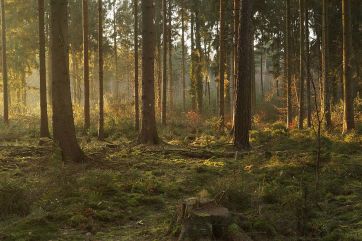The Devil’s Grandmother

|
| Geographic Coordinates: 50° 59' 22.59" N, 7° 11' 25.00" E |
Close to Bensberg in the village of Herkenrath (whose names alone hint of pre-Christian ages) there is a place in the forest between traces of old walled moats. This location has been named the “weichen Hahn” by the people who created the local land register (and who were apparently unfamiliar with the local dialect). However, it is called the “wichen Hain” (“heiligen Hain”/”holy grove”) in older writings, and the locals still know it by that name. Older people tell of grand witches’ gatherings which are presided over by the Devil and his Grandmother during the May Night and during the Mid Summer Nights. At times, poachers and foresters supposedly listened in on these night time festivals and many have paid for their recklessness with their lives. They were found as corpses with claw marks and twisted necks. Thus, even now the people living in the surrounding areas are reluctant to visit this site at night. But the tales of the marvelous experiences of the night festival and the alleged beauty of the old she-devil once tempted three young people from the neighboring village of Odenthal to indulge in their curiosity about these events. These were Frank from Scherf, Mathias from Hof, and Gerhard from Hombach. But, wisely, the three young men did not neglect to protect themselves from devilish illusions, and in Odenthal (where people knew how to deal with witches) they had the best opportunity to do so. A priest who was well-versed in such matters supplied them with blessed amulets as well as a so-called “Kreuzfettmännchen”, a copper coin with a hole drilled through its center. By looking through that hole, it was possible to see all people and objects in their true form, shorn of all illusions.
When the three young men arrived at the ill-reputed forest site at midnight, they were astonished about the large number of witches and a splendor which they had been unable to conceive before that moment. On a radiant throne, whose jeweled decorations illuminated the forest, the old she-devil sat in youthful beauty, while her grandson, the Devil himself, sat at her feet. The witches stood in a wide half-circle, and more and more of them constantly flew in to join their number. Then the witches moved and bowed under song and bright music around the throne, and the Devil’s Grandmother blessed them from a great golden water basin, using a bundle of green grain ears instead of an aspergillum, and she held a beautiful golden apple in her left hand. All of the witches appeared to be young, agile girls of a kind of bewitching beauty of a kind the listeners had never seen before, and the music was more lovely than they had ever heard.
As the witches were now arranging themselves to the dance with graceful movements and the music played even more joyful songs, the young men barely managed to restrain themselves from leaping into the witches’ rows. It was high time to use their tools of disenchantment so that they would not end up like those foresters who had been found with twisted necks. But as they looked through the opening of the Kreuzfettmännchen — what change was visible to the appalled eye! The green grain ears the old one had used for her blessings, and which had seemed to spread golden sun rays, turned out to be dirty pigs’ tails. The old one herself appeared as loathsome and ugly as it was possible to imagine for the Devil’s Grandmother, and all the young witches turned into old, wrinkled hags. The Devil, who had sat down as a handsome man at his grandmother’s feet, and all the handsome young musicians, turned into ugly devils. The beautiful top hats transformed into horns, and their faces distorted into those of larvae whose appearance was scarcely bearable for onlookers. Instead of the fiddles and flutes, horses’ heads and animal bones became visible, and the lovely music turned into discordant babble, the song into loathsome screeches. Furthermore, the most nauseating animals could be seen climbing the figures. All three onlookers fled and never again were tempted to such brazen endeavors.
Source: Schell - Bergische Sagen, p. 546f
 Sunken Castles, Evil Poodles: Commentaries on German folklore. Get the book for further context and explanatory commentary! |